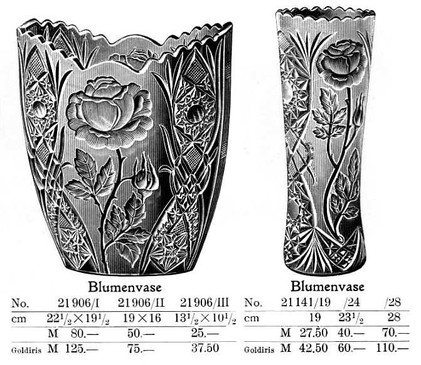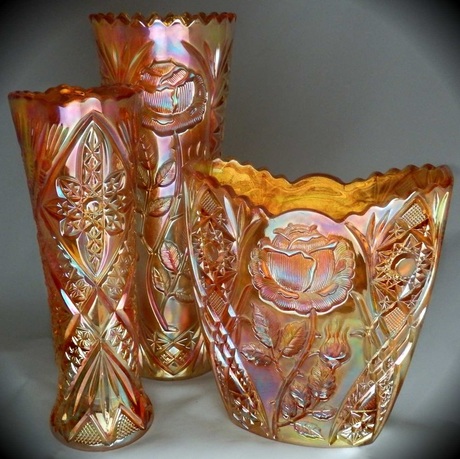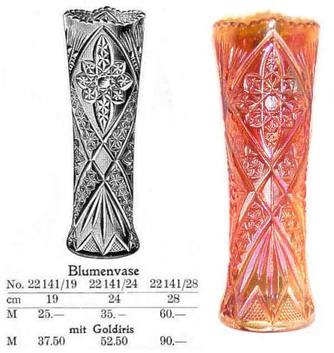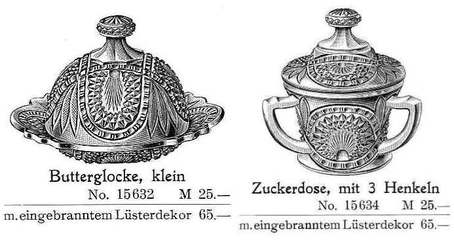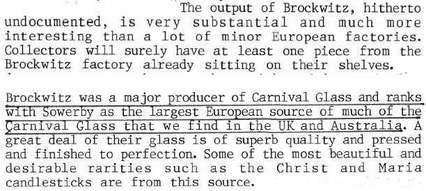A Celebration: Brockwitz's Carnival Centenary
Brockwitz was almost certainly the first maker of Carnival Glass in mainland Europe.
Edward Moore had experimented with it (we believe) in the late 1880s, however production had been dramatically limited. But for Brockwitz, we have documented production of mass-produced iridescent glass in the company’s 1915 catalogue (courtesy Dieter Neumann). The story is much more interesting and complex than that, however, as Brockwitz began making glass over a decade earlier, but no catalogues from those early years have yet been discovered.
Our recent in-depth investigation has revealed that Brockwitz were probably making pressed, iridescent glass (Carnival) from as early as c. 1905. Read our fully researched Two Part major feature: Untangling The Gordian Knot.
Edward Moore had experimented with it (we believe) in the late 1880s, however production had been dramatically limited. But for Brockwitz, we have documented production of mass-produced iridescent glass in the company’s 1915 catalogue (courtesy Dieter Neumann). The story is much more interesting and complex than that, however, as Brockwitz began making glass over a decade earlier, but no catalogues from those early years have yet been discovered.
Our recent in-depth investigation has revealed that Brockwitz were probably making pressed, iridescent glass (Carnival) from as early as c. 1905. Read our fully researched Two Part major feature: Untangling The Gordian Knot.
|
Also, there was a covering letter with the 1915 catalogue explaining that delivery times would be longer than usual due to the ongoing war and that all glass ware would be more expensive because of the political situation.
1915 was surely not the time for them to be experimenting with new techniques. It is more likely they were using existing ones. |
Brockwitz Curved Star and Rose Garden vases
in marigold (Goldiris) made in 1915. |
The 1915 catalogue image shows Rose Garden vases in two shapes: both cylinder and oval vases. Note that both are listed in all the three known sizes. Look carefully at the bottom line. The word “Goldiris” (their description for marigold Carnival) is shown for both pieces.
|
The Curved Star cylinder vase was also shown in the 1915 catalogue which you can also see below. The vase is listed in three sizes.
Note the use of the term Goldiris again, to denote that these vases were being made in marigold Carnival Glass in 1915. |
Look closely at the two items above, which were also shown in the Brockwitz 1915 catalogue. Each has the wording underneath “m. eingebranntem Lüsterdekor” meaning “with burnt on iridescence”.
To the best of our knowledge, these items have not yet been reported in Carnival, but the chances are, they are “out there” somewhere! |
Another Brockwitz pattern from 1915 was Gardestern. This is a rare marigold tumbler, and it doesn't appear in any later catalogues that we have seen. A variety of items was shown in the Gardestern pattern, including bowls and plates, but only the (rare) tumbler in this pattern has been reported in Carnival.
The lovely Many Loops and Daisy pattern also featured in the 1915 Brockwitz catalogue. Attributed and photographed by John Hodgson this is yet another piece of Brockwitz Carnival that was surely made a century ago.
Read more about these, and other Brockwitz patterns in our unique Collectors Facts.
The lovely Many Loops and Daisy pattern also featured in the 1915 Brockwitz catalogue. Attributed and photographed by John Hodgson this is yet another piece of Brockwitz Carnival that was surely made a century ago.
Read more about these, and other Brockwitz patterns in our unique Collectors Facts.
Brockwitz Carnival Glass is much sought after today, on account of its magnificent iridescence and artistry of design. Located in Germany, in the Elbe valley, not far from Dresden, Brockwitz was a major factory that began glass production in 1904 and at its height, employed over 1200 workers. Production of Carnival Glass probably began c. 1905, with fully attributed (and documented) production from c. 1914.
|
The Brockwitz Story
Writing in August 1986, the late Raymond Notley first brought Brockwitz to the attention of Carnival Glass collectors. That was some thirty years ago! On the right - his first mention of Brockwitz. In the early 1990s, we worked with glass researcher, the late Bob Smith and were able to document many Brockwitz patterns and shapes, through the catalogues that Bob had sourced. We subsequently worked with Siegmar Gieselberger in Germany, as even more catalogues appeared for study courtesy of Dieter Neumann. Today we have an almost unimaginable resource of information at our fingertips—and still fresh items continue to be discovered. |
In 2006 we gave a landmark presentation and display on "Brilliant Brockwitz" Carnival Glass. Attendees at the event made it a very memorable event by bringing an astonishing array of pieces for the display: one hundred and fifty pieces of glass in over forty different patterns.
The massed display (above) was absolutely breathtaking. Read more about this special event: Brilliant Brockwitz.
The massed display (above) was absolutely breathtaking. Read more about this special event: Brilliant Brockwitz.
Brockwitz Carnival Glass Characteristics
Over the years, as we have become more accustomed to Brockwitz's Carnival Glass, we have begun to recognise various characteristics about their output, characteristics relating to their style of patterns, colours and shapes.
Pattern style
Brockwitz patterns are mainly intaglio, imitation cut, designs—geometric or stylised florals—or more likely a combination of both. The jewel-like appearance of these imitation cut designs allows for the iridescent effect to be maximised on all the “cut” surfaces. But Brockwitz were also very clever! Several of their designs are a mixture of both intaglio and cameo mould-work. The patterns are usually exterior, but there are exceptions, such as Headdress, which can be found mainly on some Curved Star bowls, as well as some Nutmeg Grater ones too.
Colours
Most collectors know that Brockwitz used two main iridised colours—marigold (Goldiris) and blue. However, our recent research has demonstrated that they made other colours in their very early years of production. Read more: Untangling The Gordian Knot.
It is probably fair to say that marigold is more available than blue, in fact some patterns and shapes are not yet reported in blue. Conversely, we can only think of one Brockwitz piece that is known in blue, but not marigold, and that is the Draped Arcs bowl. It’s also important to note that the quality of iridescence on most Brockwitz Carnival was second to none. It is frequently truly outstanding.
Shapes
Brockwitz made an incredible range of shapes, primarily as domestic ware, ranging from massive epergnes, table centrepieces and large, showy vases down to diminutive little bowls that could fit inside your pocket. There were also unusual religious articles like the Christ and Maria candlesticks; decanter sets and water sets for drinks; flower holders with metal mesh tops plus biscuit barrels and pickle jars with lids. Many items were made in a multitude of different sizes in the same shape and pattern. Most Brockwitz items were “as moulded”; thus, the vases were not swung, and usually (but not always) pieces were not ruffled. An interesting shape is the Curved Star "vase" that is usually considered a celery vase. In the catalogues this shape was actually called a "traubenspuler" and was intended for washing grapes!
Our Brockwitz Carnival Glass Gallery is the place to go to see the range and beauty of the amazing Carnival Glass made in this factory.
We also have some unique insights into the Brockwitz factory in 1928 when senior glass workers from the UK went on a fact finding trip to Germany. The details of what they found were reported in the "British Pottery Gazette" from July 1928.

